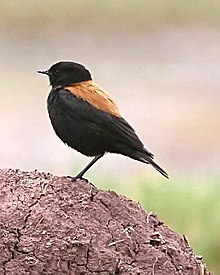| Andean negrito | |
|---|---|

| |
| Male | |
| Conservation status | |
 Least Concern (IUCN 3.1) | |
| Scientific classification | |
| Domain: | Eukaryota |
| Kingdom: | Animalia |
| Phylum: | Chordata |
| Class: | Aves |
| Order: | Passeriformes |
| Family: | Tyrannidae |
| Genus: | Lessonia |
| Species: | L. oreas |
| Binomial name | |
| Lessonia oreas (Sclater, PL & Salvin, 1869) | |

| |
| Synonyms | |
|
Centrites oreas | |
The Andean negrito (Lessonia oreas) is a species of bird in the tyrant-flycatcher family Tyrannidae found in the Andes in South America. It is closely related to, and was long considered to be the same species as, the Austral negrito of southern South America. The species is monotypic, having no subspecies.
Description
The Andean negrito is around 12.5 cm (4.9 in) long, with males being slightly larger. It is sexually dimorphic in its plumage; males having black plumage with a rufous back and silvery-white flight feathers (that are only noticeable in flight). The female has a rufous back as well but the undersides and head are sooty and the upperparts are blackish brown. The throat is whitish and the breast tinged with dull rufous. The species has exceptionally long hindclaws, like those of a pipit.
Distribution and habitat
The Andean negrito ranges through the mountainous regions of central Peru south into western Bolivia, down into north eastern Chile and northern Argentina. It is most commonly found between 3,000 and 4,000 m (9,800 and 13,100 ft) above sea level, but may go higher in Peru or drop down to 1,000 m (3,300 ft) in Chile. It lives around lakes, streams and bogs and in seasonally flooded plains, in areas with low ground cover. The species is non-migratory.
Behaviour
The Andean negrito is a terrestrial insect hunter that is found in pairs or small family groups. It often perches on elevated tussocks or rocks to watch for prey. Prey is either sallied after on the wing from on or close to the ground, or chased after on foot.
Little is known about its breeding behaviour. In Chile it breeds between October and January. Males perform a fluttering display flight that goes 10–15 m (33–49 ft) in the air. Nests are simple cups hidden inside tussock grass, into which 3–4 eggs are laid.
References
- BirdLife International (2016). "Lessonia oreas". IUCN Red List of Threatened Species. 2016: e.T22700213A93764187. doi:10.2305/IUCN.UK.2016-3.RLTS.T22700213A93764187.en. Retrieved 11 November 2021.
- ^ Farnsworth, A; Lebbin, D (2018). del Hoyo, Josep; Elliott, Andrew; Sargatal, Jordi; Christie, David A; de Juana, Eduardo (eds.). "Andean Negrito (Lessonia oreas)". Handbook of the Birds of the World Alive. Barcelona: Lynx Edicions. Retrieved 31 December 2018.